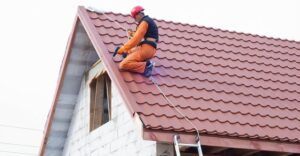Roofers build, inspect, repair, and replace roofs on residential or commercial buildings. They also install shingles and other roofing materials. They must be prepared to work in various weather conditions and follow building regulations and safety procedures. For more information visit Roofing Durham NC.
People who become roofers typically like tactile, physical, and athletic tasks. They also tend to be realistic and thrifty individuals. The job duties of a roofer are to perform installation, repairs, and maintenance work on various types of roofs. They must be able to recognize problems with the structure and integrity of roofs and fix them accordingly. Typical repair work includes fixing leaks, replacing shingles, and repairing flashing. In addition, roofers are responsible for maintaining all aspects of the roofing system, including cleaning gutters, removing debris, and inspecting for wear and tear.

In some instances, roofers may be required to install a new roof. In this case, they must accurately estimate materials and labor and provide price quotes to clients. They are also expected to adhere to all safety guidelines and take all necessary precautions when working at heights.
Lastly, roofers must be able to communicate effectively with their supervisors and other members of the crew. They should be able to follow all work orders and specifications and ensure that all jobs are completed on time and within budget. Roofers are typically responsible for preparing and cleaning their work areas and ensuring all equipment is properly stored and secured after use.
Roofers need to be comfortable working outdoors in all weather conditions. They are often required to lift heavy materials, and they may need to climb ladders or scaffolding to access the roof. They are also required to maintain a high level of personal hygiene and must be able to work quickly and efficiently.
Depending on the roofing system installed, roofers may be required to operate power tools, air compressors, or spraying equipment. They may also be necessary to punch holes in slate, tile, terra cotta, or wooden shingles using hammers and punches. In addition, they may be required to set up ladders or scaffolding to provide safe roof access. Lastly, it may be necessary to clean all surfaces before applying roofing materials. In some cases, they may also be required to assist journeymen roofers with tasks requiring less skill. Finally, they are generally responsible for sweeping and cleaning the roof after completion of the project.
Roofers install and repair the structures that cover buildings from the top. They must be able to work under different weather conditions and use various materials, such as metal, rubber, cedar shingles, and asphalt. They also must be able to read blueprints and understand construction codes. The job requires significant physical labor and is fast-paced. Some roofers may attend a trade school, although they can also get on-the-job training through apprenticeship programs.
A high school education is usually enough to qualify for a roofing position, although some employers prefer applicants who are 18 years old and in good physical condition. High school courses that can help with the job include a shop, basic mathematics, and mechanical drawing. Apprenticeships generally last three years, with beginners starting as helpers and gradually taking on more responsible tasks.
On-the-job training is the main way for roofers to learn their skills. In most programs, experienced roofers teach new workers how to use roofing tools and equipment. Beginners start with simple tasks, such as carrying equipment and erecting scaffolding and hoists. They learn to measure, cut, and fit roofing materials within a few months. Later, they are taught how to lay asphalt or fiberglass shingles.
In addition to the above qualifications, roofers should be able to work in teams and have strong communication skills. They must be able to give directions to their crew, follow them, and explain technical details about the job to clients. They should be able to deal with tight deadlines and the stress of working in high places.
Some roofers become supervisors or estimators for a roofing contractor or contractors themselves. Others choose to join a local union, which can lead to opportunities for advancement. For example, a union journeyman can become a general superintendent or an apprenticeship instructor. Roofers specializing in repairing or replacing specific types of roofing, such as lead roofs, may need a specialty license from the state.
Those who want to be roofers can work for themselves or join a company. Working as a roofer is only for some. It is very tiring and can cause backache and injuries. In addition, the working environment could be more manageable since you have to work with many tools and spend 80% of your time on the roof. You must also attend safety talks and meetings if you work for a company. However, if you are ambitious and like challenges, you can start your own roofing business.
Roofer salaries vary depending on the job, employer, and location. For example, a solar roofer’s salary may be higher than a traditional roofer’s. This is because solar roofing pays more for labor, materials, and other costs associated with the job.
Finding the right contractor is essential to repair your leaky roof or install a new one. Make sure you get a free estimate before hiring anyone. This will help you understand the costs involved and what to expect.
According to the Bureau of Labor Statistics, the number of jobs available for a roofer is expected to grow by about 2 percent from now through 2029. Areas with severe storms or regions that experience more building construction will likely have more opportunities for these workers.
The Federal Government employs roofers in various roles and at different pay grades. The simplest and most common position for a roofer is FWS-7, which pays an annual salary of $81,246.
INDENG Planet Recruitment is acting as an Employment Business for this vacancy. INDENG Planet Recruitment is an Equal Opportunity Employer. If you require further information about this vacancy, please do not hesitate to contact us.
Protects homeowners against craft errors made during the installation process. Ideally, it should cover up to 10 years of repair work. Moreover, it should cover the cost of materials. Some manufacturers even offer extended warranties of up to 30 years for roofing products. A contract is not a substitute for quality artistry, but it mitigates risk and offers peace of mind to homeowners investing in a new roof.
Besides a manufacturer’s material warranty, you should also ask your roofer about an artistry warranty. This type of warranty covers any installation errors by the contractor and can range from a few years to a lifetime. It is a great sign that the roofing contractor takes their work seriously and is willing to stand behind it.
Manufacturer material warranties typically cover shingle issues and can last several years to decades. However, they only sometimes cover problems resulting from improper installation or environmental conditions. The best thing to do is check with the manufacturer to see what kind of warranty is included with your purchased shingles.
Most reputable roofing contractors will offer standard artistry warranties for up to 25 years. These cover labor and installation error repairs and indicate a roofer’s reliability and customer service. In addition to the length of the artistry warranty, it is important to read the fine print and understand what scenarios might void the contract.
Some roofers will also offer an enhanced warranty that combines the coverage of both a manufacturer’s material warranty and a roofing contractor’s artistry warranty. This is the ideal option for homeowners as it provides them with maximum protection for their investment. However, be aware that some manufacturers require homeowners to register their warranty within a certain time frame after the completion of the project. Please do so to avoid a loss of warranty coverage. Hence, it is vital to register your warranty with the manufacturer as soon as possible after installation.




